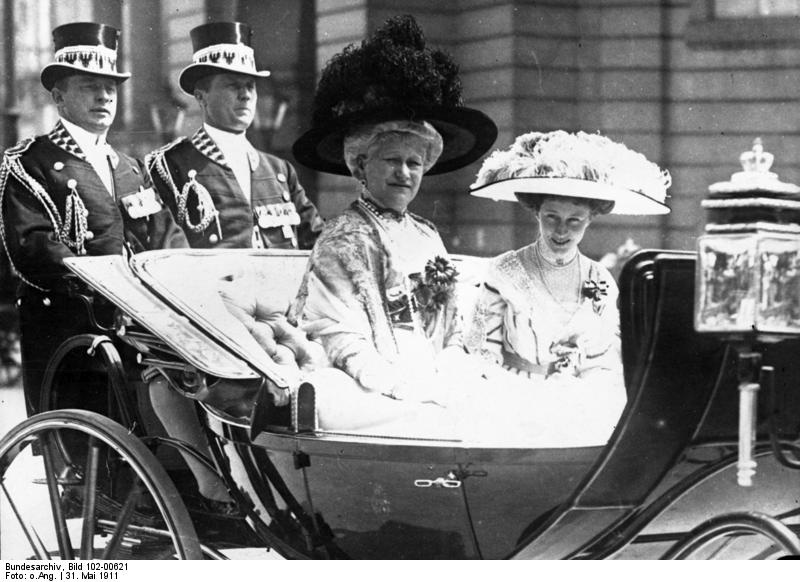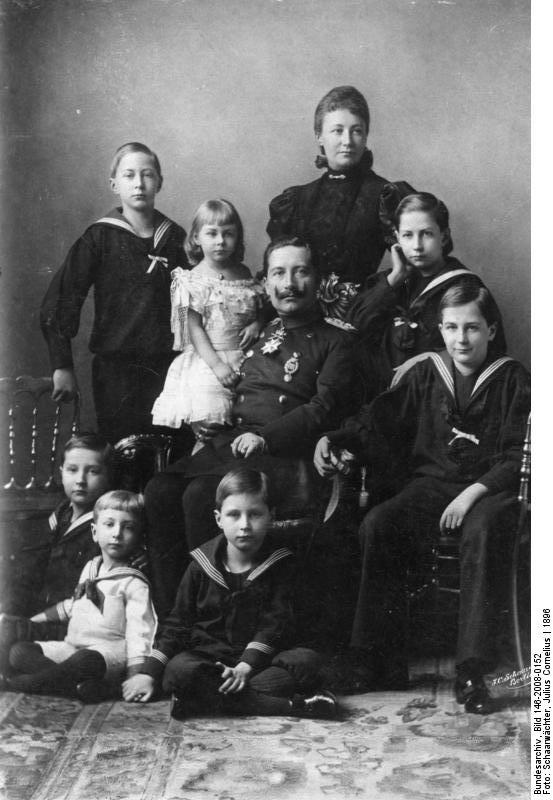Home
|
Prometheus Nr. 188
|
Alexander
Order
Royal
History: Kaiser's daughter Princess Victoria Louise was married 100
years ago
The Princess
of Prussia was a „Lady Di" of the 20th
Century"
By B. John Zavrel

The German
Empress
Auguste Victoria
with her daughter Princess
Victoria Louise
(right) during a carriage ride on May 31, 1911 in Berlin. The
Princess was 19 years young. It was the time in which the Imperial
couple were thinking about marrying the beautiful princess, which
took place two years later.
Foto: Archive History/Marco
Berlin/New York
(bpb) Princess
Victoria Louise,
the only daughter of the last German Kaiser Wilhelm
II, was
one of the most famous women of her time in Europe. Born as Princess
of Prussia on September 13, 1892 in the Marble Palace in Potsdam, she
experienced life until her death on December 11, 1980 with two World
Wars, full of highs and lows. The
Kaiser's daughter as a celebrity is compared to „Lady Di", who
was born as Lady Diana Francis and became the first wife of the
British crown prince Charles.
But the comparison can be made only regarding the popularity of both
women. Essentially, the Princess of Prussia was an aristocrat without
scandals, able to sacrifice herself as well as being an example in
fulfilling one's duties.
The internet bulletin
„Prometheus" takes the 100th anniversary of her marriage as an
opportunity to remember „the good old times" when Kaisers and
Kings normally belonged to heads of state. Naturally, these
„good old times" were also full of problems and need. But it is
in the human nature to remember especially the beauties of the
past.
Princess Victoria Louise is also well
remembered by the US-Americans of German ancestry. Who knows her
books gets the impression that the German Princess was a dutiful wife
and mother, with a difficult political fate. From childhood she had
been brought up stricly and with discipline, also with the
possibility of becoming a regent one day. But the revolutions in
Germany and the removal of aristocracy in 1918 have led to a
different development.

The „handsome
Prince" and Duke
of Braunschweig Ernst August
and the daughter of the German Kaiser were a famous couple. The
Princess of Prussia remained faithful to her husband even after his
death. She never remarried.
Marriage
reconciled the Hohenzollern and the Welfen
The daughter of Kaiser Wilhelm II.
married in 1913 the Duke of Braunschweig and Lüneburg Ernst
August Christian Georg, Prince of Great Britain and Ireland. The
marriage on May 24, 1913 was first considered an „arranged
wedding", but in the end became a marriage from love. The engagement
and falling in love with the good-looking Prince Ernst August III. of
Hannover took place on February 11, 1913 in Karlsruhe. Princess
Victoria was then 21 years old. He was her first and only husband.
The marriage at the same time meant the end of the conflict between
the two aristocratic dynasties, of the Welfen and the Hohenzollern,
which had lasted since 1866. The marriage of the newlyweds described
as „beautiful couple" was glorious and one of the last great
social events of the European aristocracy before World War I. The
„entry of the couple in Braunschweig in 1913 was rejoiced", was
reported about the event.
Children,
grandchildren and great-grandchildren until today
Princess Victoria Louise bore her
husband five children: the first-born was Ernst August IV. (1914):
followed by Georg Wilhelm Ernst August (1915), Friederike Luise
(1917), Christian Oskar Ernst August (1919) and Welf Heinrich Ernst
August (1923).
Victoria Louise's only daughter
Friederike married on January 9, 1938 in Athens the Crown Prince Paul
of Greece. Later, she became the Queen of the Hellenes. To Victoria's
grandchildren belong these still living: Queen Sophia of Spain,
ex-King Konstantin of Greece (who has been living for decades in
exile in London), and Ernst August V, who is married to Princess
Caroline of Monaco, daughter of Grace Kelly. One great-grandson of
Princess Victoria Louise is the Spanish Crown Prince Felipe, Prince
of Asturias.
Honors and loved
by the people
The beloved Princess received many
honors ever since her childhood. Already in the year of her entry
into schol in 1899 was in the center of Berlin-Schöneberg a
place was named the Viktoria-Luise Square. Later, an underground
metro station was built there, and up to this day it is a well-kept
public square in the capital, lined up with houses in art nouveau
style. In one of the magnificent buildings lived in 1930s among
others the later Hollywood producer Billy Wilder. The city of
Braunschweig named the Victoria-Luise Street after the former
dutchess, and also in 1923 the town Soltau named after her the street
bordering on the Imperial Riding School. In 1912, the air ship
Zeppelin was christened after her name. In many cities, schools were
named after her. She also gave her name to the „AMS Victoria
Louise", a training ship of the Imperial Marine. And the first
cruiser in the world carried the name Princess Viktoria
Luise.
Along these honors, the Kaiser's
daughter was life-long engaged in social, historical, cultural
activities and in social life. For many years she was the Grandmaster
of the Alexander Order for Art and Science, which maintains the
memory of the cultural heritage of Alexander the Great.

Once upon a timel:
so began most fairytales. The
photo shows the Imperial Family,
taken by the court photographer J. C. Schaarwächter, in 1896 in
Berlin. In this group photo are shown, from left to right:
Crown
Prince Friedrich Wilhelm
*6.5.1882 Empress
Augusta Victoria
*22.10.1858 Princess
Victoria
*18.9.1892 Prince
Adalbert
*14.7.1884 Prince
August Wilhelm
*29.1.1887 Emperor
Wilhelm
*27.1.1859 Prince
Eitel Friedrich
*7.7.1883 Prince
Joachim
*17.12.1890 Prince
Oscar
*27.7.1888.
End of Pomp and
Glory
The Pomp and Glory, which surrounded
the Kaiser's house and the aristocracy, ended with the World War I,
which was lost by the Germans. On November 8, 1918 also Victoria's
husband was forced to resign. The „Suffering of the Weimar
Republic" began. The World War II arrived, and iits end in 1945.
Until then, there were times in exile, as well as various residences
in Germany and abroad. The family escaped in 1945 from the Harz
region from the advancing Communist Russian troops to the Marienburg
Castle near Hannover.
The fate took its course: after the
end of her husband, in 1954 a conflict arose between her and her son
Ernst August, who had in the meantime became the head of the family.
Princess Victoria Louise finally left at the age of 62 years the
Marienburg Castle and moved in the small town of Riddagshausen. But
in the days of her need and sadness, she was supported by the
„Braunschweig Circle of Friends". With the support of this
circle of friends, Victoria Louise was active until old age in many
initiatives concerning the German life and traditions. In the years
from 1965 to 1974, the Princess attracted much public interest with
her publication of seven books about her life. In the fall of 1980
she moved into a home for old people in Hannover, where she died on
December 11, 1980. Her body was burried next to her husband in
Hannover-Herrenhausen, with great participation of the
people.
In the reverence of the people, the
Kaiser's daughter remains in their memory as a woman who has lived
the often-quoted „good German virtues", accepted joy and
suffering in life as „given by God" without lamentations and
complaints and who never lost the „belief in the good in
people".
Disclaimer: The
contents of this article are of sole responsibility of the author(s).
The journal PROMETHEUS will not be responsible for any inaccurate or
incorrect statement in this article.
www.meaus.com
contains copyrighted material the use of which has not always been
specifically authorized by the copyright owner. We are making such
material available to our readers under the provisions of "fair use"
in an effort to advance a better understanding of political, economic
and social issues. The material on this site is distributed without
profit to those who have expressed a prior interest in receiving it
for research and educational purposes. If you wish to use copyrighted
material for purposes other than "fair use" you must request
permission from the copyright owner.
For media
enquiries:
info@meaus.com
Copyright 2013
Prometheus
PROMETHEUS,
Internet Bulletin for Art, News, Politics and Science, Nr. 188, April
2013